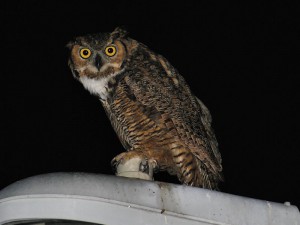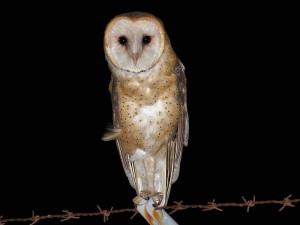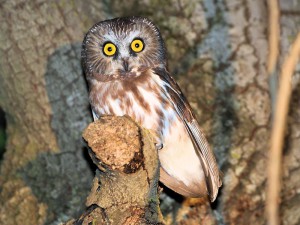We made a recent excursion to Jamaica in search of the endemic Jamaican Owl. We focused our efforts on the eastern side of the island since our time was so brief. Having read that the Hotel Mockingbird on the north-east side of the island had resident Jamaican Owls made this our first destination. The hotel is a wonderful place to stay. We did hear the Jamaican Owl although never actually saw any while we were there. Adjacent to the hotel are big trees. There may indeed be Jamaican Owls roosting in them. These “wise old owls” are certainly becoming aware of the folks who come to see them. They were unfortunately not out on open branches showing off to the tourists.
Continue reading
Tag Archives: Barn owl
Local Owls with Optics4Birding
Great-Horned Owls
Bruce Aird had birding clients in from Eastern Tennessee. He asked if I would guide them for an evening of local owling. Participants David Johnson and Jean Alexander had a list of four local owls they wanted to see. Great Horned Owl, though common nationwide, happened to be one of their owls of choice. This is our largest owl in Southern California and a very beautiful bird. They are fairly common in the city suburbs. Bruce spotted one very close to Optics4Birding sitting on a light post. I’ll bet a hundred people drove by that owl and no one even noticed it sitting there. Great Horned Owls are probably more often noticed in the city at night because of their typical owl “hoot”. Most people associate the hoot with an owl. It also tends to be fairly bold and is more commonly seen on an exposed day perch.
Barn Owls
The Barn Owl is certainly our most prevalent Southern California “city owl”. We had driven right down the road from here (the Optics4Birding Store), along Irvine Blvd, and immediately spotted a Barn Owl sitting on the perimeter fence of the El Toro MCAS (the “Orange County Great Park”). Getting out of the car and squeaking a little bit brought in two more individuals.
Barn Owls are not common in Tennessee so it was an appropriate target owl while here in So Cal. They are probably more frequent here in CA than any other state. If you watch the vineyards along the Central Valley they frequently have Barn Owl boxes in the fields for rodent control. We see and hear them here in the city all the time. Since they screech rather than hoot, their calls are often not recognized as sounds made by an owl. Barn Owls have a distinctive ghostly white appearance in flight and a unique heart-shaped white facial disk.
Western Screech-Owls
The next two target owls would take us into Silverado Canyon to get into forested habitat. The first of these was Western Screech-Owl. In oak woodlands from lowland to mid elevations, this is certainly the most common owl in the west. We had three or four individuals calling at the first location we stopped. Eventually we got great looks at one individual. The owl was within 20 feet of us. The highly territorial Western Screech Owl is very vocal so it is relatively easy to hear. Yet this owl may not be so easy to see without some practice. I have posted on Western Screech-Owl in this blog previously so did not take pictures of this one. We had one final target we hoped to show our visitors, and that bird, shown in the picture at the left was one that I would never depend on finding in mid September.
Northern Saw-whet Owls
The Northern Saw-whet Owl is a permanent resident in some of the Orange County canyons. Yet it is totally quiet at this time of year. They are small (blackbird size), uncommon, strictly nocturnal, and live in a thick habitat. This makes them almost invisible at this time of year. Even when you can locate them by sound during their vocal/breading period, they are still shy. Most often you only see some small owl whizzing by in the night and never get a good sighting.
Add a dark moonless evening in our owling equation and this bird was going to be a difficult find. I had warned the group that there was not much chance of finding this owl. Never-the-less, in a very short period of looking, we found a beautiful little Saw-whet Owl. This one was less than 20 feet away just sitting on an exposed branch for us to admire. The owl is just too cute and certainly a favorite amongst our local owls! It made for a stupendous ending to our night of owling.
Yellow-billed Magpie
 For Memorial Day weekend this year I went up to visit my family in Paso Robles. Cooking and visiting with family consumed most of my time. I got very little time to look at the birds and animals. I did though run across a few birds and managed to take a couple photos. One of the local birds that is fairly common near my folk’s ranch is the Yellow-billed Magpie. Yellow-billed Magpie is one of California’s two truly endemic birds the other being the Island Scrub-Jay of Santa Cruz Island.
For Memorial Day weekend this year I went up to visit my family in Paso Robles. Cooking and visiting with family consumed most of my time. I got very little time to look at the birds and animals. I did though run across a few birds and managed to take a couple photos. One of the local birds that is fairly common near my folk’s ranch is the Yellow-billed Magpie. Yellow-billed Magpie is one of California’s two truly endemic birds the other being the Island Scrub-Jay of Santa Cruz Island.
 Nacimiento Road to the north of town is a very good place to find this bird. In the morning on Memorial Day I took a very quick look for these unique and beautiful birds. Declining populations due to such factors as West Nile Disease and loss of habitat has caused great concern lately. They are quite vocal and their distinctive plumage makes them easy to find in the oak habitats that they frequent. The Black-billed Magpie is almost identical. Yellow-billed Magpie has always been my favorite of the two because of their striking yellow bill.
Nacimiento Road to the north of town is a very good place to find this bird. In the morning on Memorial Day I took a very quick look for these unique and beautiful birds. Declining populations due to such factors as West Nile Disease and loss of habitat has caused great concern lately. They are quite vocal and their distinctive plumage makes them easy to find in the oak habitats that they frequent. The Black-billed Magpie is almost identical. Yellow-billed Magpie has always been my favorite of the two because of their striking yellow bill.
 In my brief birding time I also took a walk one night in my brother’s vineyards. This was just irresistible since I could hear Great Horned, Barn and Western Screech-Owls at night. This young Barn Owl, who did not yet fly very well, fluttered out of a nearby tree and onto the ground right in front of me. It is such a pleasure to see so many Barn Owl boxes in the agricultural areas in the Central Valley of California.
In my brief birding time I also took a walk one night in my brother’s vineyards. This was just irresistible since I could hear Great Horned, Barn and Western Screech-Owls at night. This young Barn Owl, who did not yet fly very well, fluttered out of a nearby tree and onto the ground right in front of me. It is such a pleasure to see so many Barn Owl boxes in the agricultural areas in the Central Valley of California.
Many places across the US have seen tremendous declines in Barn Owl populations due to loss of habitat and in particular nest site availability. In a drive through the Central Valley of California you can see that many of the vineyards have put up Barn Owl nesting boxes on poles about 10-15 feet high dispersed throughout the fields. Ranchers and vineyard owners like to attract the Barn Owls because they help to control rodent populations.





